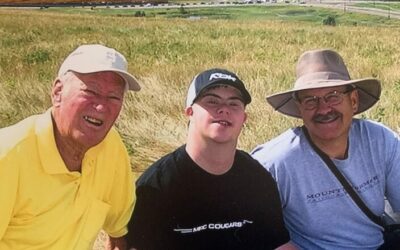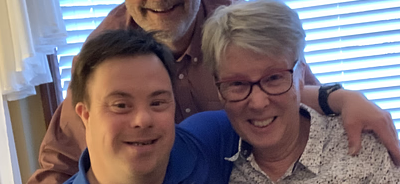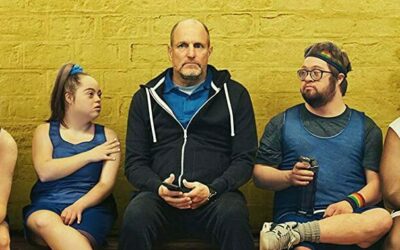CDSS: Who have you done presentations to before Paul?
Paul: I have given presentations at Down syndrome conferences, to graduates and their families, and to school groups. I have also introduced and thanked speakers at previous CDSS Conferences. I have co-hosted fund raisers, and once I even co-hosted a dance party at the top of the Calgary Tower on World Down Syndrome Day! I gave the valedictorian address when I graduated from college. I once I was also invited to speak to a class of teaching assistants.
CDSS: Who helped you to book your presentations and work out the details for each event?
Paul: For most of these presentations I was invited to speak. For the ones at the school my supervisor at CDSS arranged the details. There was a competition at my college and I was selected from several others to speak. I was assisted in preparing the presentations by my support worker and CDSS staff.
CDSS: What is the biggest group you have ever presented to?
Paul: The largest group I presented to was when I gave the valedictorian address at my college when I graduated. It was held in the Jack Singer Concert Hall in Calgary, so it might have been 800 people.
CDSS: If you are presenting to a group of adults, what kinds of things do you talk about?
Paul: When I speak to a group of adults, they are usually parents of children with Down syndrome or professionals who are working with children with Down syndrome. I talk about my life journey and how I worked to overcome my challenges. Parents like to hear about the future possibilities for their children. I also advised professionals, like teachers, about how best to include children with Down syndrome and to help them to be successful.
CDSS: If you are presenting to children, what kinds of things do you talk about?
Paul: When I speak to children, I try to show them that people with Down syndrome really aren’t that different. I tell them that we learn a little slower but we can still play their games and have fun with them. Down syndrome is not a sickness that they can “catch” by playing with us.
CDSS: Do you use video or a slideshow during the presentation?
Paul: CDSS has a great one online that you can use! The school one is here, and there are more on our website: https://cdss.ca/wp-content/uploads/2020/02/About-Down-Syndrome.pdf
CDSS: Do you practice your presentations before you are in front of the group?
Paul: Absolutely! I practice in front of my co-workers as well as my family. I try to remember to look up at the audience and not rush my words. I have to remind myself to speak slowly, loudly and clearly so that everyone will understand. I practice my presentations many many times! I even practice by reading it out loud three or four times just by myself.
CDSS: Do you use notes to stay focused on your presentation?
Paul: Yes, I always use notes. First, we write the speech out in full and then we shorten it into note form. With these notes in front of me I can remember and stay focused on what I want to say.
CDSS: Do people ask questions at the end of your presentation? What kinds of questions do they like to ask?
Paul: If there is time and depending on the type of presentation there have been questions. In a more informal presentation, there are lots of questions – mostly about my living situation and my work experience. Teaching assistants ask about my school experiences.
CDSS: Tell me about your best memories of doing presentations.
Paul: I have several good memories of doing presentations. After my valedictorian I remember getting a standing ovation. I have even performed with a band! I also really enjoy presenting to teaching assistants. They asked lots of good questions and I think it is important to work with educators to make sure that students with Down syndrome get the help they need in schools.
CDSS: What part of presentations do you find difficult and what do you do to help this?
Paul: The most difficult part of presentations for me is remembering what I want to say. I find that practicing things over and over again is the best way to remember something. I also find remembering to speak slowly and clearly is difficult. Again, practicing how to say difficult words and repeating them over and over again is helpful.
CDSS: What do you wear to do a presentation?
Paul: What I wear to a presentation depends on who I am presenting to. You should always dress in good clean clothes, but if I’m just talking to school children, I would dress more casually than if I was presenting at a more formal conference for example. Sometimes the audience will be more formal and a suit and tie is necessary. You should always be well shaved, with a good haircut, and clean clothes.
CDSS: What other advice do you have to give people with intellectual disabilities who want to start doing presentations?
Paul: I would encourage these people to take advantage of any opportunities that come along. The more often you give presentations the better you get. Not everyone though, is suited to speaking in public. Some people find it very frightening, others are very comfortable in front of a crowd. I have never been nervous giving presentations and actually enjoy them.
CDSS: Why do you think it is important to have someone with Down syndrome talk about Down syndrome?
Paul: First, it makes sense to have someone with Down syndrome talk about what it’s like, because you have experienced it. You know about the frustrations of not having people understand what you are saying. You have struggled in regular classrooms trying to keep up with the rest of the class. You have probably been bullied in school. You’ve also probably been left out of other’s games or not invited to other’s birthday parties. You know what it feels like to experience these things so who better to tell people about them?
Second, if you do a good job, sometimes people are surprised at how well you did. Then they learn that people with Down syndrome do have something to say and are capable of expressing it very well. Third, if you do a good job, parents of younger children will see you as a role model for their children, and they can see other possibilities for their child.



